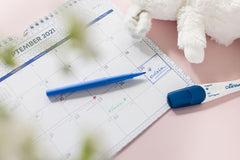Help, I'm leaking! When you're learning how to wear a cup, the last thing you want to see is red. But whether you've yet to go spot-free — or you've recently been shocked by your first overnight menstrual cup leaking episode! — you've come to the right place!
Here are a few tips and tricks to ensure that you have a flawless cup routine.

Why Is My Menstrual Cup Leaking?
First, just know that your period cup experience is completely unique. From your physical anatomy to the way your cervix shifts during your period, you may have to figure out a few to get the right seal.
When correctly positioned under the cervix (and with the pearl properly secured for the Easy-Empty™ cup), you should be able to enjoy leak-free period protection!
You may have to play detective for a bit. Identifying the reason for the leak and finding a solution may not be straightforward at first, but keep moving forward! We promise being able to go up to 12 hours + without a worry is worth the trial and error.
If you're leaking, it's typically one of the following reasons —
- Your cup did not fully open and/or seal properly.
- Your cup is not in line with your cervix.
- Your cup overfilled.
If you need a refresher, head to our post on using your menstrual cup! You'll find tips on insertion, removal, and finding the right fit and placement.
Today, we're going to tackle some common issues one at a time and give you steps to find a solution! Here are eight reasons why your cup may be leaking.
1. Is my menstrual cup leaking from a broken seal?
If you're noticing some blood pretty immediately, either it's just excess discharge that's already in the vaginal canal or there's a seal issue. Be sure to wipe well before inserting the cup. But on your heaviest days or for the first hour after inserting, you may need to wear a pantyliner.
A quick refresher on inserting and establishing the seal:
— Find the fold for you. Even if you think you've got the right fold, try a few others to see if it helps you get a seal.

— Once you fold and insert your cup, rotate it. Your cup should sit lower in your vaginal canal than a tampon. You may feel it "pop" open. Then, you can double-check position and seal by gently rubbing your finger along the vaginal wall around the top of the cup.
It should feel smooth and rounded, without any dips or bulges — the cervix will feel kinda like a bumpy nose, and you don't want to feel that after the cup has been inserted! If you do feel your cervix, simply nudge the cup over a bit to make sure the cervix is within the cup opening instead of off to the side of it.
Remember to always wash your hands before inserting a cup or your fingers into your vagina to avoid introducing any harmful bacteria.
If you're not getting a good seal, take it out, check that the small holes on the top are clear, maybe try a different fold or angle, and then reinsert.
— Gently tug on the stem to see if it feels secure. The cup should hold and not slip if you have the right seal. If you're feeling it pop open but it moves too far down, you may have too small of a cup.
Some Quick Tips:
If you're having a hard time telling if it's sealed, try inserting your thumb and pushing down on one side, to get all the air out, and then twist to seal. When sealed properly, it should always feel smooth, like the side of a balloon.
And if you have had sex recently, your muscles may take a bit to return to normal and you may not get a great seal until the next day.
2. Is my period cup not in line with my cervix?
Oh, the cervix.
It's not something you think about very often, unless you're into natural family planning, you're trying to conceive, or — you guessed it! — when you're using a cup.
If this is your first introduction to your cervix, it may help to go over the basics and download a tracking app on your phone!
Your cervix changes at different times throughout the cycle, even during your period. The post linked above will help you know if you have a tilted, high, or low cervix, which will help you determine the proper placement and avoid menstrual cup leaking.
A quick tip: Try to locate your cervix throughout the month, before your period. You'll have a pretty good idea of your placement and have a foundational understanding before testing out the cup on your flow.
— If the cup isn't in line with your cervix, you may experience some residual blood flow. If your cup is too close to your cervix, it could cause cramping and leaking (from the cervix moving into the cup and causing it to fill too quickly).

— If your cervix is titled (which is fairly common), you may think you have the cup at the right angle, but it's off just slightly. Learning where your cervix is located and ensuring the cup opening is parallel with it will help ensure leak-free success!
—If you have a low cervix, part of your cervix may dip into the cup, which may give you a reduced capacity. You may just need to empty it a bit more on those days. Also, if you're using our Simplicity Cup™, you may want to trim the stem for a more comfortable fit.

— If you have a high cervix, you may need to position the cup higher. Try inserting it at a regular height, make sure it is open all the way, and then pinch the base to move it up.
3. Is my menstrual cup overflowing?
As we said earlier, if you have a low cervix or if your cup is too high, your cervix can dip into the cup and cause it to overflow too quickly. Or you may just need to empty your cup more frequently, particularly on your heavier days.
Generally, you will feel some pressure from the weight of a full cup that alerts you, but not everyone will feel pressure. Try emptying it at 6 hours and 8 hours on your heavy days to see if that helps!
4. Are the holes on the sides clogged?
As the cup fills, the pressure in the cup is released through those small holes. If the holes are blocked, the air pushes over the edges and can start a leak. Be sure to empty your cup often during the heaviest times of your flow and check the holes whenever you reinsert the cup.
5. Is a bowel movement shifting my cup?
If you put more pressure on the cup, you may feel like it's coming out. It won't if the suction is properly there, but you may notice some blood after a bowel movement if your cup was full. Try emptying the cup and reinserting either before or after the bowel movement.
6. Strong pelvic floor muscles?
For the same reasons as number 5, if you're in the habit of doing kegels regularly, you may just have a pelvic floor that squeezes the cup, creating a temporary leak. If you see a couple of drops of blood regularly, use a pantyliner with your cup to avoid stains.
7. How do I ensure my Easy-Empty™️ Menstrual Cup isn't leaking?
If you're using the Easy-Empty™ Cup, not getting the pearl in position could be slightly traumatic!
Be sure to practice popping the pearl up and down — and get used to how it fits in the valve. Since you're typically near a sink or toilet, be sure you don't push the pearl too hard to avoid losing it!
You can test that the pearl is blocking flow by running water into your cup with the pearl in the down position. If water flows through, so can blood! Please reference the user guide included with your cup for tips and illustrations or contact us if you're having a difficult time with the valve.
8. Do I need a different cup size?
Some women, after testing different methods, may find that they do need a different-sized or shaped cup. If you have a hard time taking your cup out or if the cup is leaking all around the edge, you may need to go up a size. Or, if you can't get your cup to fully open, you may need a smaller size cup.
Know that we want to support your period care journey and are here to talk things through — our 120-day happiness guarantee covers you if things are going haywire! If you don't have a great cup experience, simply send it back for a full refund on your order. We'd love to help you determine if another cup size or cup model would serve you better.
Email us at hello@femallay.com for any help regarding menstrual cup leaking or anything else with your period care journey. We're waiting to hear from you and are always happy to help!









